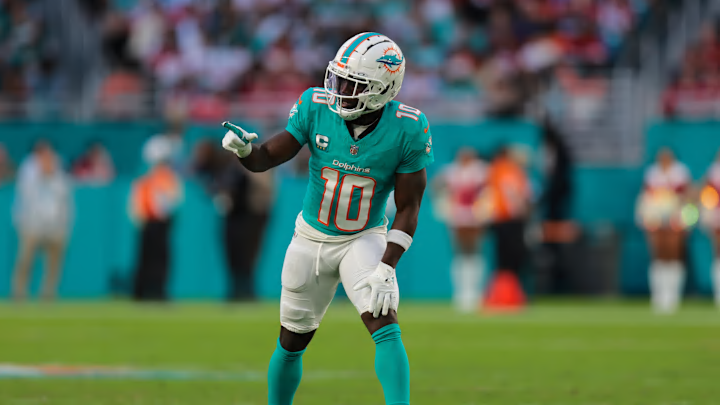
The 2024 fantasy football season saw its fair share of high-profile disappointments, as several players failed to deliver on their lofty ADPs in frustratingly distinct ways.
As we turn the page to 2025, the key question is: can these underperformers bounce back? In this breakdown, I’ll dissect each player’s situation, analyzing whether a resurgence is in the cards or if fantasy managers should remain wary.
QB Caleb Williams, Chicago Bears
Caleb Williams may not be a lock as a fantasy QB1 just yet, but his ceiling is sky-high heading into 2025. With offensive mastermind Ben Johnson now at the helm, the stage is set for Williams to take a massive leap in his second season. His rookie campaign was a trial by fire—absorbing a jaw-dropping 68 sacks (third-most in NFL history)—yet he still showcased flashes of elite playmaking, racking up 3,541 passing yards, 20 touchdowns, and just six interceptions, while adding 489 yards on the ground.
Now, with a sturdier offensive line and a strong supporting cast featuring D.J. Moore, Rome Odunze, and Cole Kmet, Williams has the weapons to elevate his game. His dual-threat ability makes him a dangerous fantasy asset, fitting the mold of modern quarterbacks who thrive both through the air and on the ground. Johnson’s system helped Jared Goff unlock consistent production in Detroit—if Williams clicks early, he could emerge as a fantasy goldmine and one of the best late-round QB steals of the draft.
WR Marvin Harrison Jr., Arizona Cardinals
Marvin Harrison Jr.’s rookie campaign wasn’t necessarily a disaster, but given his lofty draft pedigree—both in the NFL and fantasy circles—it fell short of expectations. While other teams schemed their rookie wideouts into high-percentage opportunities (just look at Xavier Worthy, Malik Nabers, and Ladd McConkey), Arizona took a far more rigid approach.
Instead of diversifying his route tree, they repeatedly asked him to win on the perimeter, forcing him into tough matchups. A staggering 19% of his targets came off go routes, and his 92.1 air yards per game ranked 10th in the league. However, he was lined up out wide over 70% of the time and was almost entirely absent from pre-snap motion, seeing just one target in such situations all season.
This rigid usage made life difficult, as Harrison faced tight coverage on 46.6% of his targets—the fifth-highest rate among qualified wideouts. On top of that, his chemistry with Kyler Murray wasn’t fully developed, particularly on timing-dependent back-shoulder throws. While the raw talent is undeniable, Arizona must make life easier for their young star by incorporating more quick-hitting plays and manufactured touches. If they do, a major second-year breakout could be on the horizon.
WR Tyreek Hill, Miami Dolphins
Few players are primed for a redemption arc quite like Hill, who endured a surprisingly lackluster 2024 campaign. The dynamic playmaker managed just 81 receptions for 959 yards and six touchdowns—his least productive season since an injury-shortened 2019. His efficiency metrics also cratered, with his yards per route run plummeting from an elite 3.9 in 2023 to a pedestrian 1.9.
However, context matters. With Tua Tagovailoa sidelined due to a concussion, Hill’s numbers took a nosedive. In games without his starting quarterback, he averaged a meager 5.8 targets, 4.2 receptions, and just 44.2 yards per game—barely flex-worthy production.
While age is creeping up, Hill’s explosiveness remains intact, and if Tagovailoa stays healthy in 2025, expect a resurgent season from one of the league’s most electrifying receivers.
TE Dalton Kincaid, Buffalo Bills
Kincaid’s TE6 ADP entering 2024 set sky-high expectations, but injuries and a frustrating role in Buffalo’s offense led to a major letdown. A midseason injury sidelined him for three games, and his connection with Josh Allen suffered—his 69.0% catchable target rate ranked dead last among 35 qualifying tight ends.
Despite the struggles, Kincaid showcased elite per-route efficiency, leading all TEs in both expected fantasy points per route and targets per route run. He also underperformed in the touchdown department based on his volume, hinting at positive regression.
However, Dawson Knox remains a roadblock. Kincaid’s 57.7% route participation ranked just 25th among tight ends, with Knox siphoning a 48.3% share. Without improved blocking, Kincaid’s snaps may stay limited, barring a shift in Buffalo’s offensive philosophy.
While an uptick in target quality is likely, volume concerns persist in Buffalo’s spread-the-wealth, run-heavy attack. All of that being said, Kincaid has TE1 upside, but his path to a top-10 finish remains murky.
